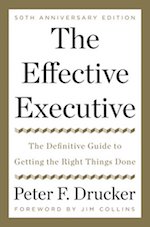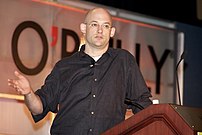 The Effective Executive: The Definitive Guide to Getting the Right Things Done (Harperbusiness Essentials) (Peter F. Drucker and Jim Collins)
The Effective Executive: The Definitive Guide to Getting the Right Things Done (Harperbusiness Essentials) (Peter F. Drucker and Jim Collins)
There are certain smart, articulate, thinkers that provide anchors for my thinking; Peter Drucker is high on that list. Somewhere around the time I was figuring out that organizations caught and held my attention, I also stumbled upon Drucker.
Not too long ago, I added a copy of The Effective Executive to my Kindle and chose to revisit Drucker’s observations about effectiveness. I’ve been uncomfortable about the surge in attention around efficiency and productivity of knowledge workers and thought Drucker might have relevant insight.
He does.
Drucker was credited with coining the term knowledge worker and the bulk of his work focused on why they mattered and what to do about it. The Effective Executive was originally published in 1966 and was reissued in a 50th anniversary edition. It’s a bit scary to contemplate the level of insight available for the taking.
Organizations consist of two kinds of people; those who follow scripts and those who write them. For a long time—and certainly in 1966—the overwhelming majority of headcount fell into the first category. Drucker’s attention was always drawn to those who wrote the scripts—executives. What’s changed since then is that scripts have become the responsibility of software. Organizations are gradually—and not so gradually—eliminating people who follow scripts.
That makes Drucker’s observations and advice about the script writers orders of magnitude more important than it was then. Drucker argued that “working on the right things is what makes knowledge work effective.†Doing the right thing is more important than doing things right, regardless of how much of the visible activity in organizations seems to be about doing things right. The Effective Executive is Drucker’s extended examination of how to systematically go about doing the right thing.
Drucker’s worldview was not tainted by today’s slavish devotion to shareholder value. In Drucker’s world, organizations exist to create and serve customers; there is no possibility of value creation, much less maximization, until a customer exists. And customers exist outside the organization. This creates a fundamental challenge for executives, which Drucker characterizes as follows:
Every executive, whether his organization is a business or a research laboratory, a government agency, a large university, or the air force, sees the inside—the organization—as close and immediate reality. He sees the outside only through thick and distorting lenses, if at all. What goes on outside is usually not even known firsthand. It is received through an organizational filter of reports, that is, in an already predigested and highly abstract form that imposes organizational criteria of relevance on the outside reality.
He goes on to say that
The fundamental problem is the reality around the executive. Unless he changes it by deliberate action, the flow of events will determine what he is concerned with and what he does.
Regardless of the changing dynamics of organization and environment, executive effectiveness consists of judgments whether a particular situation fits within the parameters of existing organizational scripts, will yield to one-time improvisation, or calls for developing a new script.
What this implies, and what Drucker argues, is that
effective decision is always a judgment based on “dissenting opinions†rather than on “consensus on the facts.†And [effective executives] know that to make many decisions fast means to make the wrong decisions. What is needed are few, but fundamental, decisions. What is needed is the right strategy rather than razzle-dazzle tactics.
Several things flow from that. Most importantly, effective decisions require meaningful chunks of time. Here, Drucker’s thinking connects closely with Cal Newport’s more recent discussion of deep work.
As is so often the case with Drucker, his insights get picked up and repackaged. Drucker’s analysis of effectiveness means that executives are engaged in design thinking. More importantly, it is design thinking that strives to synthesize the analysis and insights of multiple specialized perspectives.
There is much more in this short book. It bears close reading and regular re-reading if you aspire to do meaningful executive work. To wrap this up, I want to examine one aspect of this design thinking perspective that appears to run counter to rhetoric of many strategy efforts and many consulting proposals and reports. Let’s look at Drucker’s own words once again,
To get the facts first is impossible. There are no facts unless one has a criterion of relevance. Events by themselves are not facts.
The only rigorous method, the only one that enables us to test an opinion against reality, is based on the clear recognition that opinions come first—and that this is the way it should be. Then no one can fail to see that we start out with untested hypotheses—in decision-making as in science the only starting point. We know what to do with hypotheses—one does not argue them; one tests them. One finds out which hypotheses are tenable, and therefore worthy of serious consideration, and which are eliminated by the first test against observable experience.
The effective decision-maker, therefore, organizes disagreement. This protects him against being taken in by the plausible but false or incomplete. It gives him the alternatives so that he can choose and make a decision, but also so that he is not lost in the fog when his decision proves deficient or wrong in execution. And it forces the imagination
If finding the time and the money to pursue an MBA is currently difficult, consider adding The Effective Executive to your reading stack and put it near the top.




![Reblog this post [with Zemanta]](http://img.zemanta.com/reblog_e.png?x-id=a21c9d33-baec-4e1f-bda5-3f0565b8d4ec)